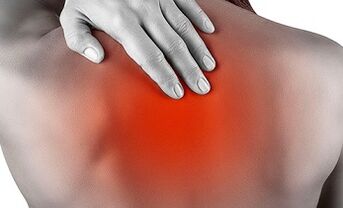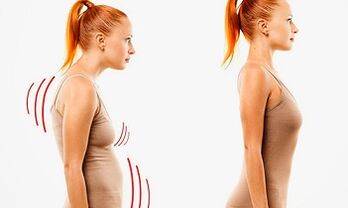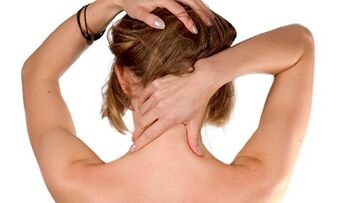Cervical osteochondrosis is a difficult disease to diagnose when the patient's initial treatment for the doctor due to a large number of signs and a slow course of the disease.
Pathology Development and Manifestation
Cervical spine osteochondrosis is found in people who carry a sedentary lifestyle and have sedentary work.
Signs

Signs of cervical vertebrae osteochondrosis are not only pain in the cervical region and the upper shoulder, but also headaches, chest pain.
Several syndromes are distinguished, each characterized by its own signs.
Rooser syndrome is due to a pinch of nerve endings in the intervertebral space of cervical spaces.Characteristic resources:
- Pain in the cervical region;
- pain in the forearm and hands;
- The tingling sensations, numbness in the forearm.
Position syndrome (or heart syndrome) is due to violation or irritation of the roots of the diaphragm nerve and (or) large thoracic muscle.In this case, the signs will serve as pain in the heart area, which will be long in time and clear in case of head rotation, sneezing or other neck movements (as in the case of angina pectoris).
Vail Artery Syndrome.The signs of osteochondrosis in this case will be:
- Pulse head pastes in the front, front (above the eyebrows) and temporal parts, which are constant;
- The auditory apparatus disorders, vestibular apparatus, vision (when osteochondrosis of cervical vertebrae is already in a neglected state) are possible.
Irive reflex syndrome.The signs of this syndrome are:
- Pulsating pains in the occipital part of the head;
- Pain in the cervical part, passing even lower to the chest or spreading to the side, in the shoulder joint;
- Strengthening pain after sleep, clear movements of the head (including sneezing, cough).
Symptoms
Symptoms with the development of osteochondrosis depend on which nervous root is damaged.In the cervical region 7 vertebrae, including nerves.Their damage causes pain in the development of osteochondrosis.

The vertebrae are considered from top to bottom and are indicated by the Roman numbers (IC, CII).The nerve endings between them are considered similarly and are designated by Arab numbers (C1, C2).The letter C denotes a cervical department (from lat. The cervical).
- In case of damage to the nerve end between the first and second vertebrae (C2), the main symptom will be numbness and loss of sensitivity in the occipital part.Later - pain there.
- Damage to the end of the nerve (C3) between the second and third vertebrae leads to impaired sensitivity in the area and later leads to impaired sensitivity and impaired language (until speech impairment).
- Damage to the nerve end between the third and fourth vertebrae (C4).In this case, the pain focuses on the clavicle, passes to the heart area and it is possible to breathe the impairment of breathing.But the pains are preceded by a feeling of numbness in a collar and shoulders.
- Damage to the nervous root of C5 between the fourth and fifth vertebrae.In case of damage, he responds with the impairment of the sensitivity of the limbs, both the upper and lower, as well as the pain in the forearm and the outside of the shoulder.
- Nerve damage ending in the area of fifth, sixth and seventh vertebrae (most common cervical osteochondrosis).The symptoms of pitch of the nerve endings of C6 and C7 are periodic numbness of fingers and hands, neck pain, forearm and below - the shoulder blade, the back, to the lower back.
- Nerve damage C8.The pain is concentrated in the neck and spreads through the forearm to the elbow and back to the lower ends.Pain is preceded by loss of sensitivity in significant areas of hands (fingers, brushes), legs (fingers, feet), skin.Blood circulation in the limbs is disturbed, which affects the color of the skin of the hands and feet.
Reasons

Cervical osteochondrosis is increasingly found among the young population.The reasons that explain the occurrence of the disease are more often in the wrong way of life than a hereditary predisposition.
Among the hereditary causes, not only a genetic predisposition to the disease is distinguished, but also the presence of chronic diseases, hereditary abnormalities of spine development.
The list of causes of osteochondrosis of cervical vertebrae associated with the way of life is very wide.These include:
- Inadequate nutrition and, consequently, overweight body weight, a disturbed metabolism in the body, lack of vitamins and minerals.
- A sedentary lifestyle caused by uniform or uniform work.Unstable physical activity.
- Severe physical activity.This includes professional sports, frequent survey of weights.
- The curvature of the spine, violation of posture, consequences of lesions in the spine, developed flat feet.
- Stress, frequent nerve tension.
Diagnosis
The diagnosis of osteochondrosis should only be made by a doctor.
Visual diagnosis
Upon contact with a neurologist and an orthopedic doctor, an examination and a patient research will initially be performed.After palpation, assessment of neck mobility and the degree of pain, the patient will be intended for hardware diagnoses.
Radiography
The method will help identify changes in the cervical region and determine its degree.For a more accurate diagnosis, it is possible to use functional radiography, when the cervical spine images are taken in various poses, which helps "capture" changes in the intervertebral space on various sides.
Magnetic Resonance Tomography

The method using magnetic pulses to obtain a tomography, in which it is possible to diagnose not only pathologies in the vertebrae and intervertebral cartilage, but also identifies the presence of intervertebral hernias, their size and location.
By using magnetic resonance imaging in diagnostic results, changes will be visible in the vascular system and nerve endings of the vertebral department.
Computed tomography
This is a detailed analysis of the condition of the vertebrae using a computer tomography and processing of the result.The method allows not only to identify changes in vertebrae and intervertebral spaces, but also to analyze the condition of soft tissues, blood vessels and ligaments.
Differential diagnosis
After sending to one of the diagnostic procedures, the doctor will conduct differential diagnosis - it will exclude the presence of other diseases in the body that have similar symptoms.This will require a blood test, an indication for other medical experts.
What is dangerous to ignore osteochondrosis?
Cervical osteochondrosis has periods of remission and exacerbation.Often, unhealthy people, without going to the doctor in time and using painkillers, feel relief and forget the problem until the next exacerbation.But the disease continues to develop, and if you keep ignoring obvious symptoms, it can lead to serious complications in the cervical region.
Among the former and, therefore, the relatively "mild" consequences of the launch of cervical osteochondrosis, protrusion and the hernia of intervertebral discs are distinguished.
In the first case, the intervertebral disk is salient, its normal location displacement between the vertebrae.At the same time, the connection fibers within the intervertebral disc (fibrous ring) remain intact and intact.
The propection in the cervical spine is severe, even with size of up to 1 mm, while in other parts of the spine these changes are not so dangerous.
After protrusion formation, destruction will affect the fibrous ring - fibers that protect the internal jacket of the pulp nucleus.Pathological changes in these structures lead to the hernia formation of the intervertebral disc.The formation and development of hernia is accompanied by increased pain syndromes and unpredictable consequences.
The most severe consequences of osteochondrosis, if there is no treatment, are vascular disorders: vegetable dystonia, hypertension and hypotension.
The formation of hernias on the intervertebral disc leads to a violation of the proper location and the functioning of the blood vessels, squeezing the arteries that feed the brain.This leads to a violation of oxygen intake in the brain and its normal work, contributes to the formation of blood clots in vessels with an additional gap.The result of the development of the disease is a stroke.
First aid
With the exacerbation of osteochondrosis, the first question the patient is confronted: "How will you get rid of pain in the cervical region?"
Drugs containing painkillers, as well as painkillers, will help remove the feeling of pain, and restriction on movements will help in the movement.
When acute pain passes, the next hours and days before going to the doctor can use anti -inflammatory painkillers.During periods of an exacerbation decline, you can use hot ointments, they will help alleviate tension in the neck and distract from painful pain.The ointments should be applied with light movements without massage.
If an attack of pain in the cervical spine found him away from the first -id kit, like a medium as an applicator, pepper patch, mustard and sandbag can help.

The applicator should be placed on a flat surface, lie in it so that it is under the cervical department, the occipital part of the head and the shoulder joint.A few minutes will have to suffer skin pain.Lying on the applicator should be 2-3 times a day for 30 to 40 minutes.
Pepper or mustard, you can use a hot sand bag, apply to the painful point on your neck, go out for several minutes.The heat will relax the muscles and distract the irritation of the pepper or the mustard of the pain.
Exercise exercises (physical therapy exercises), recommended for cervical osteochondrosis, are capable of reducing pain but for a period of time.Exercises should be done regularly during periods of remission - this will contribute to rapid treatment and reduce the severity and frequency of disease exacerbations.
After receiving first aid and removing pain, you need to seek help from doctors as soon as possible.
Treatment
The treatment of osteochondrosis is performed using different methods.
Traditional medicine
Popular and effective is drug treatment.
Drug treatment
Anesthetic tablets are used during the period of osteochondrosis exacerbation and are best suited for an ambulance for the patient.In such cases, painkillers are used.
The treatment is performed by other medicines -Anti -Inflammatories non -esteroids (NSAIDs).
Modicine uses a new type of medicine - CondoProtectors - medicines that restore cartilage fabric.
During the period of disease exacerbation, when pain syndrome can be very pronounced, doctors prescribe injections that not only relieve pain, but also have an anti -inflammatory effect.
Pain Syndrome Block

In advanced cases, during the exacerbation of pain syndrome, it may be resistant to painkillers and even painkillers injections.Then the doctor can be performed by the “block” called - the introduction of an anesthetic medicine into a source of pain using an injection.Thus, the painful section of the spine is "disconnected" of the "general nervous composition" and, for some time (depending on individual characteristics), the pain of this area does not disturb the patient.
Experienced medical staff must necessarily perform the procedure as an incorrectly filled procedure can lead to complications.The block itself is not against -indications except individual drug intolerance and can be done as often as the body requires.
Non -traditional medicine
Osteochondrosis is a disease that is not so easy to treat;Therefore, you need to approach this broadly.In the treatment of osteochondrosis, acupuncture is used.
Acupuncture is not a method of traditional medicine, but has established itself in the fight against osteochondrosis, as it allows to relieve pain and can be used during periods of exacerbation.It should be remembered that it does not bring acupuncture as such, reduces symptoms, helps to more easily transfer periods of disease exacerbation, improves neck and joint mobility and restoration and regeneration processes activated by exposure contribute to rapid recovery.
Physiotherapy
In addition to drug treatment, doctors recommend that physical therapy be performed.

- Electrophoresis.In the case of osteochondrosis, electrophoresis is used with anti -inflammatory drugs and non -esteroid analgesics in order to transmit the drug to the affected punctual area and the necessary volume.Electric current increases the effect of drugs and the procedure has the effect on treatment.
- ElectrotherapyUsing weak electrical currents and magnetotherapy using a magnetic field.They act in painful areas, relieving pain, improving blood circulation.Helps during periods of remission and trigger cell regeneration processes, accelerating the healing process.
Other physiotherapists aim to increase the blood circulation of a painful area, reducing edema and inflammation, pain and general strengthening of body immunity during treatment.
Treatment with ointments
The use of ointments for osteochondrosis is not the main method in treatment and is prescribed as an additional measure that contributes to rapid recovery.The ointments used can be divided into various groups.
- Analgesics and anti -inflammatory.Such ointments include anti -inflammatory substances analgesic and steroids.
- Hot ointments.The main component of such ointments has an annoying effect on the skin, which increases the blood supply to the site.This relieves stress, swelling, reduces pain.
- Chondoprotectorsin the form of ointments.Active substances restore cartilage tissue and auxiliary substances are relieved of inflammation and pain.
- Massage ointments.Ointments used for massage and self -massage.There are natural anti -inflammatory substances, analgesic substances, a complex of regenerating substances of plant origin.
Massage and Self -Massage

Massage with cervical spine osteochondrosis is required during periods of disease remission so as not to increase pain during the procedure.The massage is prescribed by a course of ten to fifteen sessions and is held no more than once per quarter.Massage for cervical osteochondrosis is used as a procedure that strengthens the effect after treatment and to prevent osteochondrosis.
The massage of the collar and acupressure zone at the disease distribution site is done by a specialist.The clear movements of the massage therapist help knead the neck muscles, improve blood circulation, relieve tension and after massage course, strengthen the neck muscles, which will preserve the preventive effect for several weeks and even months.
If necessary, you can perform a light massage.It is necessary to knead and grind the neck muscles, the occipital part and the shoulder muscles on the back.Simple movements in a convenient position and at any time may be an addition to the treatment and prevention of cervical spine osteochondrosis.
Self -mass is recommended for several minutes a day, has no against -indications and pain, if accompanied by movements, is easily controlled by the patient on his own.
Proper nutrition
In addition to classic treatment, physiotherapeutic procedures and massage are required for the treatment and prevention of cervical spine osteochondrosis, proper nutrition with a complete range of vitamins and minerals is required.

The main ones in this subject are vitamins A and C, strengthening the vessels.Vitamins B6 and B12 improve metabolism and amino acids in the body, help the nervous system function properly and without failure.
Complex vitamins are required during the period of remission for the overall restoration and strengthening of the body.
Traditional medicine
Popular remedies for the treatment of cervical osteochondrosis are divided into those that relieve pain and can be used for exacerbations, and those used by courses for several days or even weeks and have a therapeutic effect of long -term action.
Anesthetic Potato Compress
You will need:
- potato;
- Honey-1-2 TBSP.tablespoons for a potato.
Preparation and Application:
- Clean raw potatoes, grate.
- In a shallow bowl, mix with honey until smooth.
- Place the resulting dough in a painful point, cover with polyethylene and repair it with a diaper.Keep a compaction for 1-2 hours.
Radten infusion for anesthesia
Alcohol dyes in folk medicine are used not only to rub the painful installments for anesthesia, but also for oral administration for a general effect of strengthening and relief.
For the radish infusion in vodka, you will need:
- Black Rine - half size medium size;
- Vodka-50-70 ml;
- Honey –3-4 tablespoon.tablespoons;
- Salt - 2 tablespoons.tablespoons.
Preparation and Application:
- Peel the radish, grate in a thin grater.
- In a shallow bowl, mix until smooth: grated radish, honey, salt, vodka.
- Rub the cervical department with the mixture with the mixture twice a day during exacerbation.
- Bring the empty stomach for 1 teaspoon twice a day during an exacerbation.
Analgesic ointment that describes ginger
You will need:
- Ginger powder - 1 tablespoon.to harvest;
- Carnation of Garlic-2-3;
- butter.
Preparation and Application:
- Fry ginger powder in a pan in a small amount of butter.
- Peel the garlic, grate in a thin grater or moa with a fall.
- In a shallow bowl, mix fried ginger powder and garlic until smooth.
- The resulting ointment can be rubbed at a painful point with exacerbations or used as a tablet, tied with a diaper for a few minutes to a burning sensation on the skin.
Oil with rubbish to rub
Oil rubbing with slight osteochondrosis massage is used during periods of disease remission and is done with 10 to 15 days courses with a pause.
You will need:
- Oregano (grass) - a handful;
- Olive oil (can be sunflower) 300-500 ml.
Preparation and Application:
- Pain (grass) shake finely.
- Add the oregano to a bottle of oil and let it infuse in a dark place for at least one day.
- Strain the oil, also squeezing oregano from the oil.
- Use the infused oil to rub and light massage from the place affected by osteochondrosis 1 time.
Night Compress made of rabban
You will need:
- RABAN-RABANO-3PCS.
- boiling water.
Preparation and Application:
- Immerse the leaves of the rabbin for a few seconds in boiling water (softens).
- Apply softened leaves in the place affected by osteochondrosis, tied with a diaper and isolation with a scarf.
- Leave the compress of the leaves of the rabane at night.The feeling of hint of light is quite acceptable.
- The procedure is performed during the remission of the disease, with a course of 5 to 7 procedures with an interval for 2-3 weeks.
Lemon -changing cocktail
You will need:
- Lemon - 1 PC.;
- garlic head-1 (5-6 teeth);
- boiling water.
Preparation and Application:
- Peel the lemon from the shell, seeds, move with a blender or pass a meat grinder.
- Peel the garlic, move with a passion or grid in a thin grater.
- Mix lemon and garlic in a large jar or bottle, pour a mixture of 0.5 liters.boiling water.
- Insist the resulting mixture of at least 12 hours (leave at night).
- The lemon lemon cocktail is consumed daily in half a glass with an empty stomach in the morning.
You can store a cocktail in the refrigerator, prepared as needed.The course of taking a cocktail is 1 month.
Strawberry tea
You will need:
- Forest strawberries (fresh or dry) - 1 tablespoon.to harvest;
- 1 cup of boiling water.
Preparation and Application:
- Figure bruses from the floor pour boiling water like tea.
- Insist at least 10 to 15 minutes.
- Drink with 2-3 cups osteochondrosis per day.
Medical Physical Education
One of the causes of osteochondrosis is hypodynamia - the lack of physical activity against the bottom of a sedentary lifestyle.Performing only a few simple exercises will help alleviate the exacerbation of the disease or prevent its appearance.
Exercises "for home and office"
Resistance
- Press the palm of the occipital part of the head press it, making the effort of the neck muscles.With the hand to resist.Keep a voltage of 10 seconds.
- Change the position of the hand, putting it on your forehead and now try to put in front in front.It also resisted about 10 seconds.
- Change the position of the hand, placing it with a palm in the temple (right hand in the right temple), also resist the pressure of the hand on the head.Keep a voltage of 10 seconds.
- Change your hand and side application side, now to resist the left (left hand to the left temple).Keep a voltage of 10 seconds.
- Change the situation alternately, repeating the exercise up to 5 times for each position of the hand.
Heads of the head standing
- Stay straight, straightening your shoulders.
- Make the head heads as much as possible to the right and left alternately.
- Lower your head to the chin to the neck.
- Make the same heads with your head as much as possible to each side, slowly and without tearing your neck chin.
- Perform exercise slowly, repetition rotates up to 5 times on each side in each of the positions.
Head Tilts Standing
- Rest your shoulders and throw your head back.
- Tilt your head to the left and right, trying to reach your shoulders with your ear.
- Do the exercise slowly and repeat up to 5 times on each side.
Lying exercises
Raising your legs
- Lying on your back, stretch your arms and legs freely.
- Put your legs, pull your knees into your stomach as you pull your head up, trying to put your eyes with your knees.
- Revalving himself, lowering his head and smoothing his legs and arms again along his body lying down.Repeat slowly 5 times.
Head shifts lying down
- Lying in the stomach, smoothing your legs, put your arms along the body.
- Turn your head left, trying to put it on the floor with your right ear and then turn the turn from the head to the right, also trying to reach the floor now with the left ear.
- Repeat the heads of the head to 5 times in each direction.
When performing all exercises, it should be remembered that in the case of the manifestation of pain, you should refuse to perform the exercise and consult a doctor.
Prevention
Prevention of cervical spine osteochondrosis is a healthy lifestyle:
- Physical Education and Sport (moderately).With a tendency to osteochondrosis, swimming will be the best assistant.It strengthens the shoulder and neck muscles.
- Balanced diet.Include a large number of products containing calcium, magnesium, vitamins (cottage cheese and dairy, peas and other legumes, walnuts, fish and seafood) in the diet.
- Break at work sitting.At every opportunity, we try to knead the muscles of the neck and back.
- Excessive load.Do not use much and often gravity (including bags in one shoulder).
- Orthopedic pillows and mattresses.Use it if possible.
- Not fat.Overweight accelerates the development of osteochondrosis.Stay on the scale more often.
To control the condition of the cervical region, it is recommended to make diagnoses at least once every 2-3 years: conduct a magnetic resonance imaging or computed tomography.
In addition, an examination of doctors should be performed at least 1 time a year: a surgeon and a neuropathologist.Treatment of any disease is easier and faster if you start when the first signs appear.
























